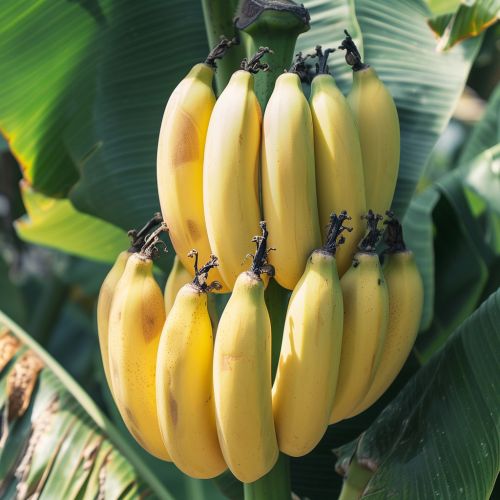Musa (genus)
Introduction
Musa is a genus of flowering plants in the family Musaceae. The genus includes bananas and plantains, which are among the most significant fruit crops worldwide. The Musa genus is native to the tropical regions of Southeast Asia and is extensively cultivated in many tropical and subtropical regions. This article delves into the taxonomy, morphology, distribution, cultivation, and economic importance of the Musa genus.
Taxonomy
The genus Musa is classified within the family Musaceae, which also includes the genera Ensete and Musella. The taxonomy of Musa has undergone significant changes over time, with molecular phylogenetic studies providing new insights into the relationships within the genus.
Species and Subspecies
The Musa genus comprises several species, with Musa acuminata and Musa balbisiana being the most prominent. These two species are the primary progenitors of the cultivated bananas and plantains. Hybridization between M. acuminata and M. balbisiana has resulted in various cultivars with different ploidy levels, such as diploid, triploid, and tetraploid.
Morphology
Musa plants are large, herbaceous perennials with a pseudostem formed by the leaf sheaths. The true stem is a rhizome that produces new shoots and roots. The leaves are large, spirally arranged, and can reach up to 3 meters in length.
Inflorescence and Flowers
The inflorescence of Musa is a terminal spike, also known as a banana bunch. It consists of a series of bracts, each enclosing a cluster of flowers. The flowers are unisexual, with male flowers located at the tip of the inflorescence and female flowers at the base.


Fruit Development
The fruit of Musa is a berry, commonly referred to as a banana. The fruit develops from the female flowers and grows in clusters called hands. Each hand contains multiple bananas, and a bunch can have several hands.
Distribution
Musa species are native to the tropical regions of Southeast Asia, including Malaysia, Indonesia, the Philippines, and Papua New Guinea. They have been widely distributed and cultivated in tropical and subtropical regions worldwide, including Africa, the Americas, and the Caribbean.
Cultivation
Musa plants are cultivated primarily for their fruit, but some species are also grown for their fiber and ornamental value. The cultivation practices vary depending on the species and the intended use of the plant.
Propagation
Musa plants are typically propagated vegetatively using suckers or tissue culture. Suckers are shoots that arise from the rhizome and can be separated and planted to produce new plants. Tissue culture involves the use of meristematic tissue to produce disease-free plants.
Soil and Climate Requirements
Musa plants thrive in well-drained, fertile soils with a pH range of 5.5 to 7.5. They require a warm, humid climate with temperatures between 25°C and 30°C and an annual rainfall of 1000 to 2500 mm.
Economic Importance
Bananas and plantains are staple foods for millions of people in tropical and subtropical regions. They are rich in carbohydrates, vitamins, and minerals, making them an essential part of the diet. The global banana trade is a significant economic activity, with major exporting countries including Ecuador, the Philippines, and Costa Rica.
Uses
Apart from being consumed as fresh fruit, bananas and plantains are used in various culinary applications. They can be cooked, fried, or processed into products such as banana chips, banana flour, and banana puree. The leaves of Musa plants are used as wrapping material in cooking and as plates in traditional cuisines.
Pests and Diseases
Musa plants are susceptible to several pests and diseases, which can significantly impact yield and quality. Some of the major pests include the banana weevil (Cosmopolites sordidus) and the burrowing nematode (Radopholus similis). Diseases such as Panama disease (Fusarium wilt), black Sigatoka (Mycosphaerella fijiensis), and banana bunchy top virus (BBTV) are also of significant concern.
Conservation
The conservation of Musa genetic diversity is crucial for the sustainability of banana and plantain cultivation. Efforts are being made to conserve wild Musa species and traditional cultivars through in situ and ex situ conservation methods. In situ conservation involves protecting the natural habitats of wild Musa species, while ex situ conservation includes the establishment of germplasm banks and tissue culture repositories.
